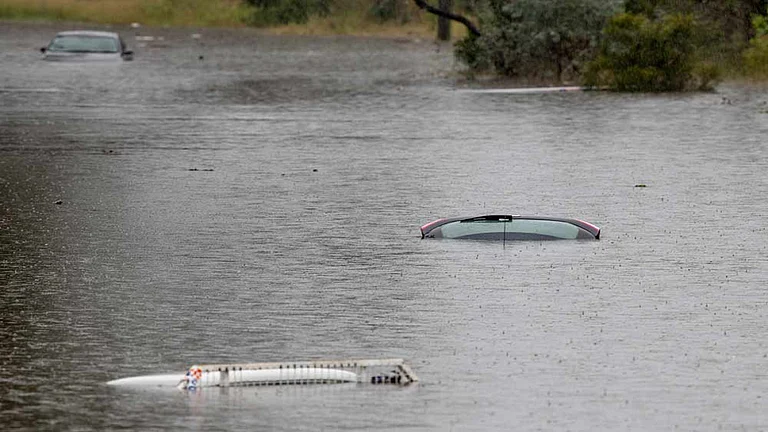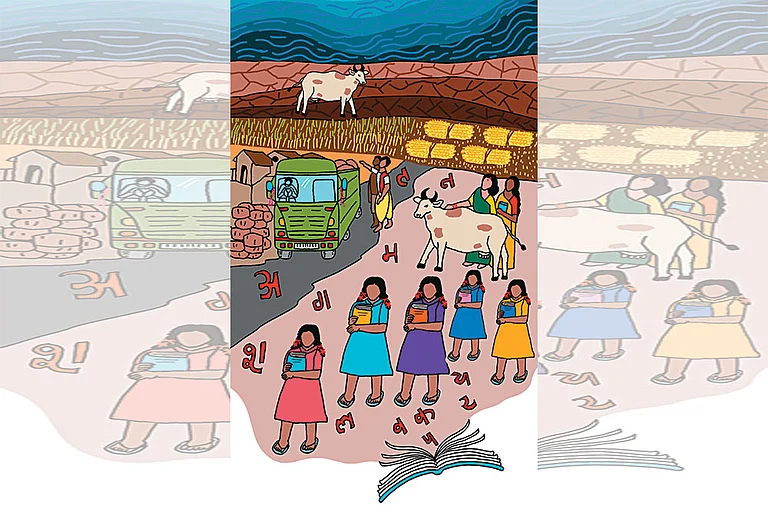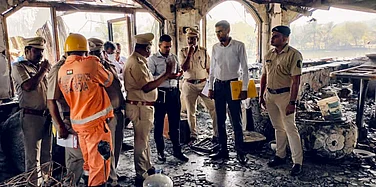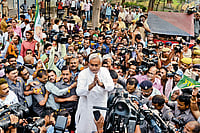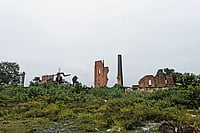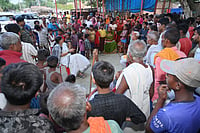When I was travelling on the Kosi river’s embankments in Supaul district of Bihar, which shares a border with Nepal and faces annual floods, I met octogenarian Singheswar Rai in his thatched hut. He was singing a song, which he had penned in the 80s. It talked about the devastation of the Kosi river. The concluding lines were about the hope of turning everything right one day.
Dheeraj dhariha mangru chacha mann mat kariau malaal,
Samay pavi ke taruwar Foure, jaanaiye sakal jahaan.
(O Uncle, don’t be sad, be patient,
The whole world knows that trees bear fruit in their own time)
But it seems he had hoped against hope. That fruit is nowhere to be seen. The floods are so frequent that they have become a part of people’s lives.
People have now learnt to live with this disaster, which knocks on their doors with the onset of the monsoon and stays with them for around two to three months, causing huge economic losses.
Twenty-nine-year-old Priyanka Kumari, who lives in Manna tola (village cluster) in Supaul district, starts preparing for the Kosi floods every year around May. “We start stocking rations like rice, wheat flour, pulses and edible oil so that we have food for those three months,” she says.
Apart from this, she keeps a good stock of chiura (flattened rice) and biscuits. “When it rains and we don’t have dry wood to cook, we consume dry food,” she adds.
She has two children – a girl, 6, and a boy, 3. She keeps both children with her during the floods. Her husband, Pramod Ram, works as a teacher at a school run by a non-governmental organisation.
Kumari’s parents live outside the embankment area, so ,while growing up, she had not experienced flooding. “I had a sketchy memory of the flood but after marrying within the embankment in 2012, I am experiencing floods almost every year,” she says.
“Water levels start increasing in Kosi from May, so we start arranging chowkis (raised platforms) and collecting wood for cooking fuel. When the flood comes, we keep one chowki on another one and stay on it. We keep rations and other essential items on the chowki. We stay on another chowki,” she says.
“When heavy flooding begins, the tube wells also get submerged. In that case we have to drink river water. What other option do we have?” she asks.
People who stay in their homes during the floods have developed a trick to cook food on the chowki.
Sixty-year-old Md. Maroof, a resident of Khokhnaha village in Supaul, whose flood memory goes back to the eighties, says, “We put a thick layer of soil on one side of the chowki and put a tin sheet over it. After that, we put an earthen chulha (stove) on it and cook food. The layer of soil and the tin prevent the chowki from burning.”
I noticed that many houses within embankments had chowkis which had black spots indicating the parts used for cooking.
The regular floods and erosion within the embankment have forced most families to build makeshift thatched houses. “Every year we face floods as well as erosion. If we build a pucca house spending lakhs of rupees and it erodes in river water, we will face huge losses, so we build thatched houses instead of pucca houses,” says Satyanarayan Yadav, a resident of Nirmali village, another hamlet within the embankments.
“Just see my house, you will not find a spider’s web. You know why? Because every year we build our house afresh, so spiders don’t get a chance to make webs,” he laughs. Yadav is in his 60s and he remembers that his house was destroyed more than 40 times due to floods and erosion. He also lost a huge chunk of agricultural land to river erosion.
The Kosi river, which is called Bihar ki Shok (Sorrow of Bihar), originates in the Himalayas. It enters Bihar via Nepal. The river, which brings huge quantities of sediment, flows for about 260 km in Bihar and joins the Ganga at Kursela. Earlier, there were no embankments so the river would flow freely.
A research paper titled “GSI in Flood Hazard Mapping: A Case Study of the Kosi River Basin, India” by Rajiv Sinha of IIT Kanpur, shows that the river has moved 150 km from its original course over the last 200 years. Kosi is one of the few rivers in the world which changes route so quickly.
Older people on the embankments remember that the floods would come earlier as well but the water would recede in three to four days, causing less devastation. In the late 1960s, the then prime minister, Pandit Jawaharlal Nehru, and President, Dr. Rajendra Prasad, decided to build embankments on both sides of the Kosi river so that it flows within a 10 km radius.
At that time, it was decided that the population on the embankments would be compensated by allotting land outside the catchment areas. Land was assigned to them but the people never got possession of it as it was grabbed by powerful land mafias and dabbangs (overlords). As these families had no land outside the embankments, they were forced to stay within them. Since then, they have been facing the wrath of the floods almost every year.
According to official data, there are around 3.5 lakh acres of land between the two embankments and about 8 lakh people stay within the embankments in eight districts of Bihar. The majority of this population lives in Supaul and Saharsa districts. Md. Maroof and Priyanka among them. The government has left this large population in the lurch, without basic facilities like roads, health centres or schools.
The government had, in the early 80s, formed a committee under the chairmanship of the then Saharsa district council chief, C.K. Pathak, for the economic development of people living within the embankments. The recommendations of the committee paved the way for the formation of the Kosi Victims Development Authority (KVDA) in 1987. But nothing was done for the people living within the embankments.
Mahendra Yadav, a social worker and founder of Kosi Navnirman Manch, an organisation working for the rehabilitation of the Kosi victims, says, “KVDA is non-existent. There were many programmes planned for implementation in the embankment area. But they did not see the light of the day. Let alone the implementation of projects, people of Kosi embankments are not given emergency facilities during floods.”
On 4 February this year, hearing a public interest litigation, the Patna high court asked the Bihar government to form the Kosi Development Authority, to ensure the safety, liberty and development of the people impacted by floods, but victims do not have any expectations from this. Not only has the government failed the Kosi flood victims, the mainstream media has also ignored their agony.
Every time there is flooding, the media reports it as a routine news item and provides information relating to affected people, water levels and government relief camps. Most often, the details do not match ground realities. The media hardly ever asks questions about why the government continues to fail the people and not protect them given that the floods have been making an annual appearance for decades now.
In an affidavit to the Patna high court, the state government has claimed that it has incurred Rs 12776.30 crore of losses on flood management work in north Bihar in one decade. The question then is: why did 2,408 people die and crops worth Rs 3,800 crore get damaged, according to the Disaster Management Department, Bihar, over one decade?
Kumari, who spends Rs 35,000 to make her thatched home afresh every year, says “We don’t get any help from the government. So we have no expectations from the government in the future as well. I faced losses due to floods two years ago but I am yet to receive Rs 6,000 from the government.” She wishes to move to a safe place, but every year the flood drowns her wishes.
“We need huge amounts of money to buy land outside the embankment to make a home. We somehow save some money but every year a flood comes and we have to spend all our savings to build a new home and arrange food,” she says ruefully.
(This appeared in the print edition as "Drowning Dreams")
(Views expressed are personal)
Umesh Kumar Ray is a Bihar-based independent journalist









